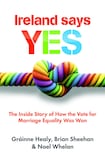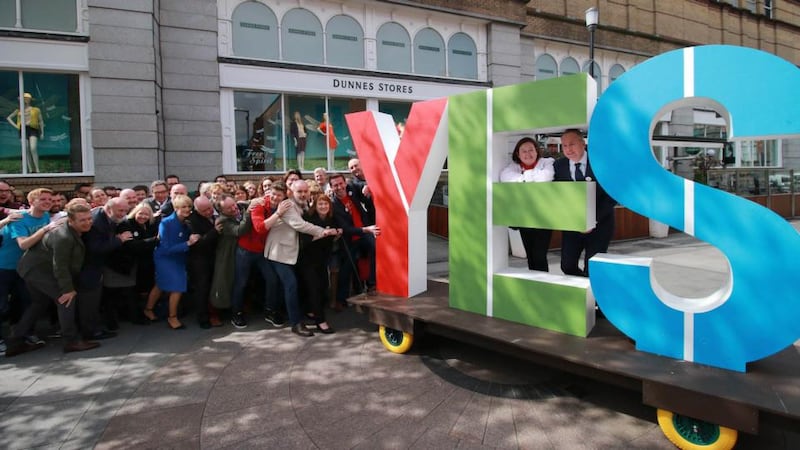
Gay people in Ireland over the past half-century have been lucky with their leaders, and indeed supporters. While figures such as David Norris, Katherine Zappone and Ann Louise Gilligan used the legal system with considerable intelligence and bravery, others such as Tonie Walsh, Kieran Rose, Chris Robson, Edmund Lynch and Ailbhe Smith worked tirelessly and ingeniously as activists in a time when the notion of decriminalisation seemed a distant dream, not to speak of equality. Both Tonie Walsh and Edmund Lynch have been involved in recent years in collecting stories from gay people in Ireland and managing an archive for future generations.
In Una Mullally's In the Name of Love, an invaluable oral history of the movement for marriage equality, published last year, there is a fascinating moment when Tonie Walsh notes that, in his early fifties: 'I'm of a generation not just of gay activists, but of a generation that just grew up with this idea that actually, as sexual outlaws, the type of relationships we wanted were there to be claimed in whatever form we wanted…most of us weren't particularly interested in marriage.
“The reason we weren’t interested in marriage was deep down we imagined it was unattainable and maybe that’s indicative of how simply oppressive and repressive society was.”

Undercurrents
This feeling that Ireland was unreformable made its way into the very core of gay life in the 1980s, especially after David Norris lost his case in the Supreme Court in 1983. But, as with any period in history, it is useful to look at the undercurrents as much as obvious trends.
Thus it is worth watching the figures who continued to believe that change was possible, the men and women who, using quiet persuasion and cogent argument, attended meetings and wrote discussion documents.
These activists set about making us more visible not only to the straight world but also to ourselves. The move from being sexual outlaws, with all the fleeting underground fun which that entailed, to May 23rd, 2015, at Dublin Castle, when we were the toast of Ireland, was mirrored in the changing way gay people in Ireland fell in love, planned our future, saw ourselves. In Ireland in those years, for gay people, the political slowly became personal.
There were, for those working for change, a number of ways to proceed. In 2005, for example, Brian Sheehan, then the director of the Lesbian and Gay Film Festival in Dublin, invited Michael McDowell, then minister for justice, to open the festival because he believed that the gay movement would need McDowell as an ally. Others, of course, disapproved of McDowell's politics and did not wish to sup with him despite his support for greater equality.
Serious split
There was subsequently every possibility of a serious split between those, led by the organisation known as GLEN, of which Sheehan was one of the leaders, who were willing to operate within the political system, seeking gradual reform as a way of achieving equality, and those, led by Marriage Equality, who believed that compromise – civil partnership, for example, rather than marriage – would merely copper-fasten inequality.
The clash between the two organizations had echoes of the Civil War in 1922. (“It was always like a civil war or something,” Kieran Rose remarked.) One side was for accepting civil partnership as a step towards further progress; the other side wanted all or nothing.
While it moved gay life close to national life – with Brian Sheehan from GLEN as Michael Collins and Gráinne Healy of Marriage Equality as de Valera – it was unlikely that this was any consolation to those involved for whom these divisions were serious and pressing. In the chapter of Una Mullally's book called "The Division Continues', Brian Finnegan, the editor of Gay Community News, wrote: "I suppose there's an unhealthy relationship between Marriage Equality and GLEN." Gráinne Healy, from Marriage Equality, wrote: 'I don't know if we'll ever all end up being bosom pals having Christmas drinks together, but that's okay. That's not an important thing."
Ireland Says Yes, then, is the remarkable story of how peace broke out, how a number of gay groups, so at odds with each other just a short time before, put duty first to create a tightly organised, hugely efficient and broad-based election machine.
The tensions between them, instead of producing a stand-off or a permanent split, seemed instead to give them productive energy. By the end of the book not only are they having drinks together, they are working so closely that the very names of Brian [Sheehan] and Gráinne [Healy] merge into a figure popularly known (and generally celebrated) as ‘Brainne’. If only Michael Collins and Éamon de Valera – “Meamon” – had been gay, or as wise as Brian and Gráinne, Ireland could have been spared much hardship.
Forensic and revealing
The book that Gráinne Healy, Brian Sheehan and Noel Whelan have written is a detailed, sober, forensic and revealing account of how the Marriage Equality campaign was run. It will be used as a handbook for anyone seeking public office in Ireland and elsewhere in the future, and will be an invaluable tool for teachers and students who wish to study what a political campaign is like, and what implementing a coherent strategy under pressure means.
It is an inspiring story of how passionate engagement can be turned into political change; it is the best book we have now on the inner workings of our democratic process. The problem, of course, is that the book almost tells us too much. If I were a Catholic bishop or an activist on the No side, I would pore over its pages and learn a lot. Having found out so much about the imagination, passion, cunning and political savvy of the leaders of the Yes campaign, it might be tempting for the No side to echo Patrick Sarsfield and declare: "Change kings and we'll fight you over again." In any political battle, I would not like to have the authors of this book on the opposing side. Now that the leaders of Yes Equality have let us know how it is done, can we really complain if a group we disagree with learns from the secrets and strategies revealed in Ireland Says Yes?
The central idea behind the campaign was to show civility rather than anger, to use what the authors call “a soft tone”. The campaign wished to make clear that we, as gay people, wanted to belong, that we are Irish as well as gay, and members of families who love us before we are anything.
In a way, we took the word love from those who had belittled our love, and we reclaimed it. This meant that the campaign did not propose anything abstract or philosophical, but instead just asked its canvassers to tell particular, concrete stories, or let others do so. The aim was to make things personal rather than political, to make the campaign local rather than national, to ask for votes one at a time rather than demand rights, to evoke, as the authors of this book write,”‘the collective values of Irish people”.
This involved careful and watchful management and enormous discipline. The team who ran the campaign included seasoned gay activists who were joined by figures such as barrister and political pundit Noel Whelan, Martin Mackin, the former general secretary of Fianna Fáil, Mark Kelly of the Irish Council for Civil Liberties, Colm O'Gorman of Amnesty, Fergus Finlay, former general secretary of the Labour Party and chief executive of Bernardo's, Bride Rosney, former adviser to Mary Robinson, and barrister Peter Ward. They were careful also to include and work with the main political parties.
Excitement and stability
There is a sense in the book that the campaign followed the classical Irish roadmap where the winning side in any election or referendum campaign becomes more cautious than the electorate while also capturing the electorate’s imagination. Voting Yes offered both excitement and stability, much as the Mary Robinson campaign, in which Bride Rosney was involved, did, or the Mary McAleese campaign, in which Martin Mackin played a central role.
The best example of this caution in the book is when Breda O’Brien, perhaps the most likeable and formidable among the No campaigners, challenged Panti Bliss to a debate. Our authors write: ‘The idea worried the Yes Equality communications team . . . [It] risked exactly the kind of caricature that everyone on the Yes side was anxious to avoid during the campaign . . . If for any reason it went wrong, it would be a game changer for the No side, and sitting on a comfortable lead in the polls, Yes Equality knew they didn’t need that.’
Panti herself, as astute as she is intelligent, knew that too. She was keeping in touch with Brian Sheehan throughout the campaign; her lack of day-to-day involvement in the debates is drily summed up here: “They both agreed that, in the crucial last weeks, less was best when it came to media opportunities [for her].”
It might have been tempting for the Yes campaign to have depended on social media, to have caused the hashtag to replace the poster on the pole in Irish election campaigns. Instead, they worked hard at creating posters, slogans, badges; they sent a bus around the country; they worked hard briefing supporters who were to do radio and TV debates; they understood that door-to-door canvassing in a country like Ireland remains an essential element in winning any campaign. They also, of course, used social media with enormous skill.
While their operation was modern and slick, it was also old-fashioned and traditional, managing not to alienate their own core vote while succeeding in persuading other people to move towards them. They must be the envy of anyone in politics.
Parents and grandparents
Central to their success was the use of parents and grandparents, the allowing of gay people to be seen with their loving families, the use of figures like Mamo McDonald, former ICA president, Tom Curran from Fine Gael, and a wonderful couple from Louth, Brighid and Paddy, 50 years married, who made a brilliant video.
Perhaps the jewel in the crown was the involvement late in the campaign of Mary McAleese. What is significant here is that the former president did not merely appear for a photo-shoot, but made a closely argued and brilliantly written 40-minute speech.
She made clear that she took the voters seriously. Also, as the mother of a gay man, she underlined that there was a great deal at stake for her personally, as for many other parents. She moved the personal and the political closer to each other than they had been at any other time in the campaign.
Although this book has many moving moments, it is not filled with flourish or colour. It is as considered and careful, in its tone, as the campaign was, and all the more useful for that. There are some very funny moments, however, not least at the end of book as the world made its way to Panti Bar in Dublin to find that the regulars were watching the Eurovision Song Contest. When what the authors call “Noel Whelan’s considerable bulk” was blocking the view of the TV screen, someone shouted at him to get out of the way. Then they were hastily informed who he was. And then there were hushed apologies. “The dour pundit,’ the authors write, “had, for one day at least, become a gay icon”.
Ireland, that day, became a gay icon too. It is a credit to the authors of this most sober, informative and illuminating book that we now know how this came about.
Colm Tóibín's most recent book is On Elizabeth Bishop
